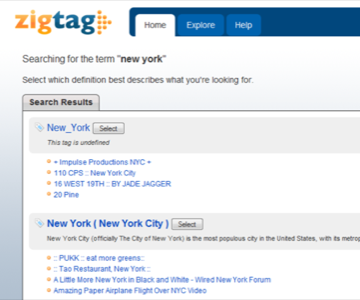It was two years ago that we first heard of Zigtag, a service that promised to “transform how people search, save and share knowledge & information.” Now, after a nine-month private beta, this semantic tagging service has finally launched. But is Zigtag’s bookmarking tool intelligent enough for 2009?

About Zigtag
For those of you who don’t know, Zigtag is another entry in the social bookmarking collection of tools. Like delicious, Diigo, and Ma.gnolia, Zigtag helps you categorize your bookmarks and share them with others. When Zigtag went into development, bookmarking was all the rage. The company’s goal was to make bookmarking easier by adding a layer of semantics to the tags themselves.
Zigtag, you see, understands the meaning of the words you assign to a tag. When you tag to a page, Zigtag actually assigns it meaning rather than just a simple word. If that sounds revolutionary…well, that’s because it is. Sort of.
Not the Only Semantic Tagging Service
Because of Zigtag’s slow progress, they can no longer claim to be the only semantic tagging application available today. Another, Faviki, also offers an intelligent tagging service based on structured data. Both services attempt to address the problem of user-generated tags. That is, even though what you tag “NY” may be the same link that I tagged “New York,” no bookmarking service ever knew the tags were related.
Zigtag and Faviki attack this problem in different ways. Faviki suggests tags for you to use, not from a community of users and their tagging history, but from structured information extracted from DBpedia, a community-maintained database created by extracting information from Wikipedia.

Zigtag, however, eschews suggestions and lets you tag items as you wish. It doesn’t matter what personal system you use for tagging (one word, two words, underscores, plus signs, etc.) because Zigtag understands the meaning of the tags. In Zigtag, a link tagged “New York” is returned along with other links tagged “New_York.” Zigtag also understands that one tag may have different meanings and groups those items accordingly. For example, there’s a New York and Company clothing store and a New York in England that may have been tagged “new york.” That level of understanding is something that’s unique to Zigtag and sets it apart from other bookmarking services.
Thanks to the service’s ability to understand meaning, Zigtag users can join groups related a shared interest. Since Zigtag knows what you mean by your tags, it is, in theory, easier to find links you would be interested in on Zigtag than with other bookmarking services.
Is This Really Web 3.0?
Zigtag may be one of the first tools to step out of the Web 2.0 box. Where “Web 2.0” implies there is a social element to a service, it’s generally speculated that Web 3.0 will bring about the intelligent web. Zigtag delivers this intelligence, but is it enough?

The only downside to Zigtag is that it requires you, the user, to manually insert the tags. In fact, it even relies on user-generated tagging and has built its entire service around that concept. That may be where Zigtag went wrong. Although two years ago, what it offered was ground-breaking and unique, as we enter 2009, we’re asking the question: “Is tagging dead?”
At first, collaborative tagging, also known as a folksonomy, appeared to be the future of the web. It was a rejection of the search engine in favor of the community. It was our collective intelligence harnessed for the purpose of applying meaning and order to the pieces of the web in ways that computer-based tools could not.
As time went on, though, the one thing that made a folksonomy appealing – it was made by people! – was also the very thing that gave it problems. User-generated tags were likely to produce unreliable results. Zigtag addresses that problem, but it does not address what may end up being the true source of failure for folksonomy-based systems: people are lazy.
Now that there are myriads of services using tagging, thanks to the explosion of Web 2.0, we’re getting sick of all the manual labor involved. Tag your links, tag your photos, tag your blog entries, tag your RSS feeds, etc.
While at one time, a semantic-based tagging system like Zigtag may have seemed like a vision of Web 3.0, we’ve now come to a point where we wonder if it does enough. It’s possible the next revolution of the web won’t be a system that understands the meaning of the tags we created, but knows how we would have tagged things if we had bothered to do so and then does it for us. And if that’s not the future of the web…well…perhaps it should be.
Tagging photo courtesy of flickr users cambodia4kidsorg





















